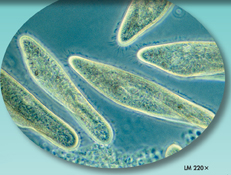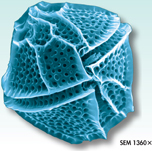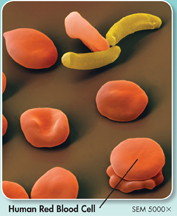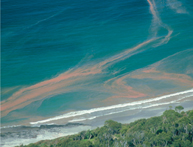
Paramecium multimicronucleatum is the largest paramecium, with cells that are visible to the naked eye.
CILIATES
These common organisms may contain hundreds or even thousands of short cilia extending from the surface of the cell. The cilia propel the ciliate through the water, and may sweep food particles into a gullet. Ciliates are large compared to other protists, with some cells exceeding 1 mm in length.
DINOFLAGELLATES
Dinoflagellates are photosynthetic protists found in both fresh and salt water. Their name comes from their two distinct flagella, usually oriented at right angles to each other. Roughly half of dinoflagellate species are photosynthetic; the other half live as heterotrophs. Many dinoflagellate species are luminescent, and when agitated by sudden movement in the water, give off light.

The two flagella of dinoflagellates originate in grooves within thick plates of cellulose that resemble a cross shape, as shown here (genus Protoperidinium).

Apicomplexans in genus Plasmodium are mosquito-borne parasites. Shown in green are the remnants of a red blood cell that burst when plasmodia reproduced inside.
APICOMPLEXANS
The apicomplexans (AYP ih kum plek sunz) are named for a unique organelle near one end of the cell known as the apical complex. This structure contains vesicles with enzymes that allow apicomplexans to enter other cells and take up residence as parasites.
Eco•Alert
Toxic Blooms
Dangerous Dinoflagellates
Great blooms of the dinoflagellates Gonyaulax and Karenia have occurred in recent years on the East Coast of the United States, although scientists are not sure of the reason. These blooms are known as “red tides.” Gonyaulax and Karenia produce a toxin that can become amplified in the food chain when filter-feeding shellfish such as oysters contentrate it in their tissues. Eating shellfish from water affected by red tide can cause serious illness, paralysis, and even death.

A red tide containing toxic dinoflagellates
Table of Contents
- Formulas and Equations
- Applying Formulas and Equations
- Mean, Median, and Mode
- Estimation
- Using Measurements in Calculations
- Effects of Measurement Errors
- Accuracy
- Precision
- Comparing Accuracy and Precision
- Significant Figures
- Calculating With Significant Figures
- Scientific Notation
- Calculating With Scientific Notation
- Dimensional Analysis
- Applying Dimensional Analysis




